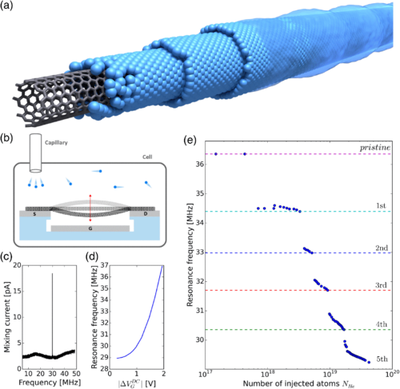Quantum mechanics explains how superfluid helium films grow in carbon nanotubes
Jul 12, 2019
A study by an international team of researchers, led by ICFO scientists and with the participation of Jordi Boronat, a researcher from the Physics Department of the UPC, shows the controlled growth process of superfluid helium, layer by layer, in the surface of carbon nanotubes. The experiment opens the door to studying new phenomena at the nanoscale and, specifically, in transitions of topological phases.
The study, led by Adrian Bachtold, of the Instituto de Ciencias Fotónicas (ICFO) -a university research institute affiliated with the Universitat Politècnica de Catalunya · BarcelonaTech (UPC) - and with the participation of researchers from the Department of Physics of the UPC, from the École Normale Supérieure (ENS, Francia) and from the Universidad Pablo de Olavide (UPO), shows how superfluid helium grows in carbon nanotube-forming layers and not continuously. Carbon nanotube resonators have proven to be excellent detection devices for the study of new physical phenomena at the nanoscale (for example, in the transport of quantum electrons, in surface sciences and in light-matter interaction), while superfluid helium is useful for the study of phase transitions and, specifically, to understand the transitions which happen in two and three dimensions. Combining them, it is possible to study different nanoscale phenomena, such as adsorption, supersolidity and superfluidity.
In the experiment, published in Physical Review Letters, the international team of researchers has fixed a carbon nanotube at both ends - so that the nanotube could stretch and oscillate like a guitar string - inside a camera where helium vapor has been added to observe how superfluid helium films were absorbed onto the surface of the suspended carbon nanotubes. The study shows that, as helium accumulates in the nanotube, the frequency of the mechanical vibrations of the nanotube changes as its mass increases. That is, they have observed that, as the tube absorbs helium, the resonance frequency changes abruptly. This indicates that the accumulation of helium in the nanotube has been carried out layer by layer, with discontinuities both in the number of atoms absorbed and in the speed of the third sound of the absorbing film. In this process, they have been able to demonstrate the formation of helium layers up to five atoms thick.
Liquid helium is one of the quantum systems par excellence and its study requires advanced theoretical methods. The Barcelona Quantum Monte Carlo research group, led by Jordi Boronat, a researcher at the Physics Department of the UPC, has participated in the theoretical analysis of the experiment in collaboration with UPO researcher Carmen Gordillo. The theoretical modeling of the quantum system has predicted the different phases that have been observed in the experiment. The data obtained in the ICFO confirm the theoretical predictions and show, for the first time, and clearly, that the growth of the layers adsorbed on a nanotube occurs in jumps, as corresponds to first order phase transitions.
The combination of experimental and theoretical results show that the team has been able to build superfluid helium films with several atomic layers in a controlled manner and that these multilayers of helium absorbed in a nanotube are of unprecedented quality compared to previous studies. These results open a new research path in the field of transitions of topological phases with the aim of carrying out new investigations in quantum fluids and solids of reduced geometry.
In the experiment, published in Physical Review Letters, the international team of researchers has fixed a carbon nanotube at both ends - so that the nanotube could stretch and oscillate like a guitar string - inside a camera where helium vapor has been added to observe how superfluid helium films were absorbed onto the surface of the suspended carbon nanotubes. The study shows that, as helium accumulates in the nanotube, the frequency of the mechanical vibrations of the nanotube changes as its mass increases. That is, they have observed that, as the tube absorbs helium, the resonance frequency changes abruptly. This indicates that the accumulation of helium in the nanotube has been carried out layer by layer, with discontinuities both in the number of atoms absorbed and in the speed of the third sound of the absorbing film. In this process, they have been able to demonstrate the formation of helium layers up to five atoms thick.
Liquid helium is one of the quantum systems par excellence and its study requires advanced theoretical methods. The Barcelona Quantum Monte Carlo research group, led by Jordi Boronat, a researcher at the Physics Department of the UPC, has participated in the theoretical analysis of the experiment in collaboration with UPO researcher Carmen Gordillo. The theoretical modeling of the quantum system has predicted the different phases that have been observed in the experiment. The data obtained in the ICFO confirm the theoretical predictions and show, for the first time, and clearly, that the growth of the layers adsorbed on a nanotube occurs in jumps, as corresponds to first order phase transitions.
The combination of experimental and theoretical results show that the team has been able to build superfluid helium films with several atomic layers in a controlled manner and that these multilayers of helium absorbed in a nanotube are of unprecedented quality compared to previous studies. These results open a new research path in the field of transitions of topological phases with the aim of carrying out new investigations in quantum fluids and solids of reduced geometry.
Layering Transition in Superfluid Helium Adsorbed on a Carbon Nanotube Mechanical Resonator.
A. Noury, J. Vergara-Cruz, P. Morfin, B. Plaçais, M. C. Gordillo, J. Boronat, S. Balibar, and A. Bachtold.
Phys. Rev. Lett. 122, 16530

Share: